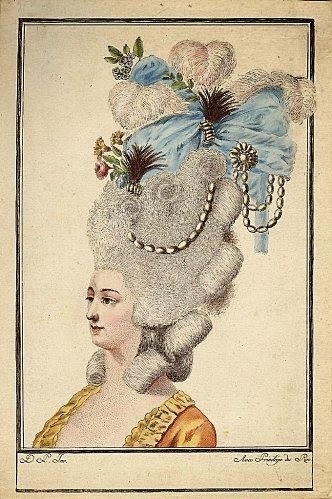 |
| Anonymous, Coëffure à l’Indépendance ou le Triomphe de la liberté, c. 1778. In the collection of the Musée franco-américain du château de Blérancourt. |
Probably the most famous of these coiffures [hairstyles] is the hairstyle featuring a model ship. These ship headdresses appear in numerous illustrations of the period and continue to influence contemporary fashion. I even donned one of them myself. In late 18th century France, these nautical headdresses were expressions of patriotism and political engagement. The first was the coiffure à la Belle Poule and celebrated a famous French naval victory against the British during the American Revolution. During the Battle of Ushant on July 27, 1778, the French ship Belle Poule badly damaged the British frigate Arethusa. To celebrate this victory for the cause of American independence and express French patriotism, women adorned their hair with small models of the Belle Poule. Other famous naval battles were similarly memorialized. The coiffure à la Frégate la Junon celebrated another famous French frigate, and the chapeaux [hat] à la Grenade and à la d'Estaing celebrated the French victory at the Battle of Granada led by Admiral d'Estaing.
Another politically inspired coiffure was the coiffure à l'inoculation which was commissioned by Marie Antoinette to celebrate the successful inoculation of Louis XVI against smallpox. While smallpox inoculations were common in Austria (Marie Antoinette's birthplace), they were less popular in France and Louis XV died of smallpox. Louis XVI was inoculated against the disease at the urging of Marie Antoinette but it was a risky move. Many were suspicious of the procedure, labeling it "dangerous", and urged the king not to go through with it. When Louis XVI was successfully inoculated and given a clean bill of health it was a major political victory for Marie Antoinette, and she celebrated her victory with a coiffure featuring the serpent belonging to Aesculapius, the Ancient Greek god of medicine, wrapped around an olive tree (symbolizing wisdom).
 |
| A coiffure au sentiment. |
Other coiffures celebrated topical cultural themes or personal events. A coiffure au sentiment expressed a feeling while a coiffure à la circonstance celebrated an important event. The coiffure à l'Iphigénie celebrated the popular opera Iphigénie en Aulide (1774) by Christoph Willibald Gluck. In an age of global exploration and trade, the theme of the different ares of the globe was often represented in fashion and textiles. The coiffure à la Mappemonde was a hairstyle showing the five parts of the globe. The pastoral was also another extremely popular theme throughout the eighteenth century and many coiffures were commissioned with this theme in mind. A coiffure au jardiniere worn by Marie Antoinette featured a vegetable garden with carrots, radishes, artichokes, and even a head of cabbage. And the Duchesse de Choiseul once wore "a three-foot-high pouf that replicated a verdant garden, replete with flowers, grass, a bubbling stream, and a tiny windmill edged with jewels and powered by a clockwork mechanism that Louis XVI himself might have admired." Other coiffures were more personal. To celebrate the birth of her son, the Duchesse de Chartres wore a coiffure featuring her African page and pet parrot as well as a nursemaid nursing a newborn baby.
 |
| Satirical print showing a coiffure au jardiniere complete with the tiny figure of a man going for a stroll. "The Flower Garden" by Matthew Darly, May 1, 1777. In the collection of the Metropolitan Museum of Art. |
Of course these hairstyles were ripe for satirizing and many prints were published poking fun at these elaborate coiffures.
What would you don on your own coiffure?
Further Reading
Chrisman-Campbell, Kimberly. "When Fashion Set Sail." Published on Worn Through, March 20, 2013.
Weber, Caroline. Queen of Fashion: What Marie Antoinette Wore to the Revolution. New York: Henry Holt and Company, 2006.
